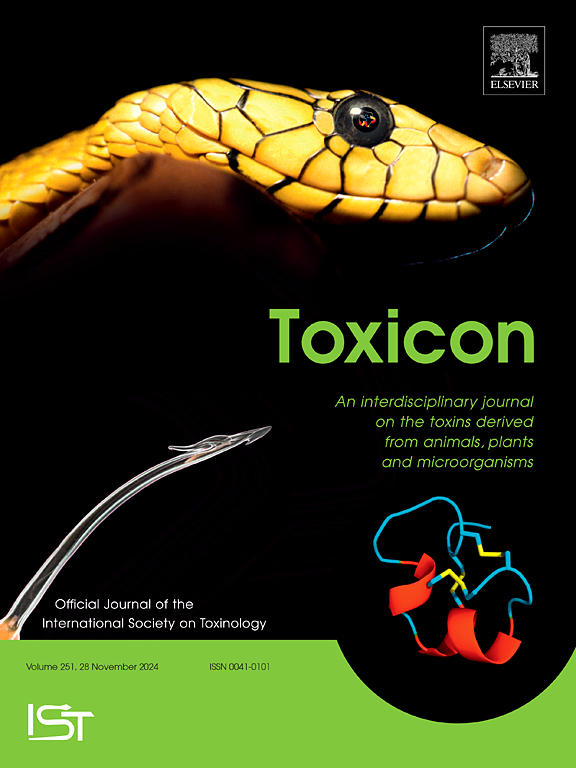Occurrence of regulated, emerging, and masked mycotoxins in Chinese wheat between 2021 and 2022
IF 2.6
4区 医学
Q2 PHARMACOLOGY & PHARMACY
引用次数: 0
Abstract
Wheat is one of three major food crops in China. Wheat grains are prone to contamination with various mycotoxins. The risk of exposure to mycotoxins through the consumption of wheat flour has long been a concern. This study evaluated the occurrence of regulated, marked, and emerging mycotoxins in 304 wheat samples that were randomly sampled from major wheat-producing regions of China. Aflatoxin B1 (AFB1) was detected in only 3 wheat samples, with a maximum concentration of 2.37 μg/kg. Deoxynivalenol (DON) was identified as the most prevalent mycotoxin, being present in 94.4 % of the samples with a maximum concentration of 2.84 mg/kg. Additionally, 11.5 % of the positive DON samples exceeded the maximum Chinese limit of 1000 μg/kg. The incidence of zearalenone (ZEN), zearalanone (ZAN), α-zearalenol, and β-zearalenol in wheat samples were 27.96, 2.96, 2.63, and 2.63 %, respectively. Of 304 wheat samples, 86.2 %, 14.5 and 7.24 % were positive for Deoxynivalenol-3-Glucoside (range: 3.58–609 μg/kg), 3-AcDON (range: 2.31–95.97 μg/kg), and 15-AcDON (range: 2.26–76.65 μg/kg), respectively. Beauvericin (BEA) was detected in 89.14 % of wheat samples with the maximum concentrations 114 μg/kg. However, the average concentration of BEA (2.40 μg/kg) in the positive samples was less than 10 μg/kg. Alternariol (AOH) and moniliformin were detected in 48.68 % and 16.78 % of wheat samples, respectively. Most wheat samples (89 %) were simultaneously contaminated with more than one mycotoxin, with an average of approximately five mycotoxins per sample, and up to 15 mycotoxins were detected in individual samples. In conclusion, DON was the most prevalent mycotoxin in wheat samples, followed by D-3-G, BEA, and AOH, and co-contamination of mycotoxins in wheat samples were very common.

2021年至2022年中国小麦中受管制、新出现和隐藏真菌毒素的发生情况
小麦是中国三大粮食作物之一。小麦籽粒容易受到各种真菌毒素的污染。长期以来,通过食用小麦粉而接触真菌毒素的风险一直是一个令人担忧的问题。本研究评估了从中国主要小麦产区随机抽取的304份小麦样品中受管制、有标记和新出现的真菌毒素的发生情况。黄曲霉毒素B1 (AFB1)仅在3份小麦样品中检出,最高浓度为2.37 μg/kg。脱氧雪腐镰刀菌醇(DON)被确定为最普遍的霉菌毒素,存在于94.4%的样品中,最大浓度为2.84 mg/kg。此外,11.5%的DON阳性样品超过了中国最高限量1000 μg/kg。玉米赤霉烯酮(ZEN)、玉米赤霉烯酮(ZAN)、α-玉米赤霉烯醇和β-玉米赤霉烯醇在小麦样品中的含量分别为27.96%、2.96%、2.63%和2.63%。304份小麦样品中脱氧雪腐镰刀菌醇-3-葡萄糖苷(3.58 ~ 609 μg/kg)、3-AcDON (2.31 ~ 95.97 μg/kg)和15-AcDON (2.26 ~ 76.65 μg/kg)的检出率分别为86.2%、14.5%和7.24%。Beauvericin (BEA)在89.14%的小麦样品中检出,最高浓度为114 μg/kg。而阳性样品中BEA的平均浓度(2.40 μg/kg)小于10 μg/kg。在小麦样品中分别检出48.68%和16.78%的异丙胺醇(AOH)和念珠双胍(moniliformin)。大多数小麦样品(89%)同时被一种以上的霉菌毒素污染,每个样品平均约有5种霉菌毒素,在单个样品中检测到多达15种霉菌毒素。综上所示,小麦样品中最常见的真菌毒素是DON,其次是D-3-G、BEA和AOH,小麦样品中真菌毒素的共污染非常普遍。
本文章由计算机程序翻译,如有差异,请以英文原文为准。
求助全文
约1分钟内获得全文
求助全文
来源期刊

Toxicon
医学-毒理学
CiteScore
4.80
自引率
10.70%
发文量
358
审稿时长
68 days
期刊介绍:
Toxicon has an open access mirror Toxicon: X, sharing the same aims and scope, editorial team, submission system and rigorous peer review. An introductory offer Toxicon: X - full waiver of the Open Access fee.
Toxicon''s "aims and scope" are to publish:
-articles containing the results of original research on problems related to toxins derived from animals, plants and microorganisms
-papers on novel findings related to the chemical, pharmacological, toxicological, and immunological properties of natural toxins
-molecular biological studies of toxins and other genes from poisonous and venomous organisms that advance understanding of the role or function of toxins
-clinical observations on poisoning and envenoming where a new therapeutic principle has been proposed or a decidedly superior clinical result has been obtained.
-material on the use of toxins as tools in studying biological processes and material on subjects related to venom and antivenom problems.
-articles on the translational application of toxins, for example as drugs and insecticides
-epidemiological studies on envenoming or poisoning, so long as they highlight a previously unrecognised medical problem or provide insight into the prevention or medical treatment of envenoming or poisoning. Retrospective surveys of hospital records, especially those lacking species identification, will not be considered for publication. Properly designed prospective community-based surveys are strongly encouraged.
-articles describing well-known activities of venoms, such as antibacterial, anticancer, and analgesic activities of arachnid venoms, without any attempt to define the mechanism of action or purify the active component, will not be considered for publication in Toxicon.
-review articles on problems related to toxinology.
To encourage the exchange of ideas, sections of the journal may be devoted to Short Communications, Letters to the Editor and activities of the affiliated societies.
 求助内容:
求助内容: 应助结果提醒方式:
应助结果提醒方式:


